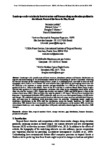Please use this identifier to cite or link to this item:
http://www.alice.cnptia.embrapa.br/alice/handle/doc/1002573| Title: | Landscape-scale variation in forest structure and biomass along an elevation gradient in the Atlantic Forest of the Serra do Mar, Brazil. |
| Authors: | LEITOLD, V.  KELLER, M.   MORTON, D. C.   SHIMABUKURO, Y. E.   |
| Affiliation: | VERONIKA LEITOLD, INPE; MICHAEL KELLER, USDA/PESQUISADOR VISITANTE CNPM; DOUGLAS C. MORTON, NASA; YOSIO E. SHIMABUKURO, INPE. |
| Date Issued: | 2015 |
| Citation: | In: SIMPÓSIO BRASILEIRO DE SENSORIAMENTO REMOTO, 17., 2015, João Pessoa. Anais... São José dos Campos: INPE, 2015. |
| Pages: | p. 1192-1199. |
| Description: | Landscape-scale quantification of forest structure, disturbance patterns and biomass distribution can improve our understanding of the environmental controls on the functioning of forested ecosystems. Assessing the detailed structure of the complex tropical forest canopy is a challenging task, especially in areas of steep topography where field access is limited. We used airborne lidar (light detection and ranging) data to describe the landscape-scale variation in canopy structure and gap distribution in a 1000-ha area along an elevation gradient from 0 to 1200m in the Atlantic Forest of the Serra do Mar in southeast Brazil. Mean canopy heights (MCHs) were greatest (21-22m) at intermediate elevations (200-700m) in the submontane forest where terrain slope was also the steepest (~40º). Canopy gap fraction was highest (~30%) and MCH lowest (~16m) in the montane forest areas (900-1100m) on flatter sites atop the plateau (~24º slopes). We used forest inventory data from nine 1-ha permanent field plots (PFPs) within the study area to assess aboveground biomass (AGB) stocks and changes. We established regression models based on lidar-derived canopy structure and field-based biometry data, and used these to extrapolate AGB predictions across the landscape. Comparing canopy height and disturbance distributions in the PFPs with the distributions across the broader landscape, we found that submontane PFPs showed closer correspondence with their surrounding areas, while montane PFPs consistently overestimated landscape-scale canopy height (thus AGB pools) and underestimated gap fraction (therefore AGB changes). |
| Keywords: | Airborne lidar Biomass dynamics Canopy structure Gap distribution Permanent field plots Tropical montane forest |
| Type of Material: | Artigo em anais e proceedings |
| Access: | openAccess |
| Appears in Collections: | Artigo em anais de congresso (CNPM)  |










